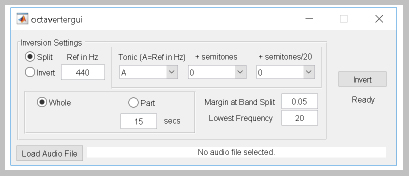
Octaverter™ is short for Octave Inverter. It's a twenty-first-century algorithm inspired by 1930s voice scrambling technology that turns audio upside down—making melodies go up where they originally went down, turning timbres on the heads, and yet keeping recordings recognizable through it all in ways that verge on the uncanny.
You can read about how it works here. Or you can just listen to some examples of what it can do:
Octaverter is based on well-established principles of frequency inversion, demonstrated in their basic form here on a 6 kHz audio file of the Beatles' "I Want to Hold Your Hand." By inverting source audio in octave-width bands, however, it's able to produce much more aesthetically worthwhile effects.
Want to try your own hand at octave inversion? I've created a Windows 10 executable from my experimental MATLAB code, and you can download a zipped installer for it here. I haven't tested it beyond my own laptop computer, so if you try it out, please let me know how it goes!
The input can be a WAV or mp3 file; the output will be a WAV. The "Inversion Settings" panel is where you specify the frequency points at which inversion will take place. If you select "split," you'll choose the frequency at which bands are split, and if you select "invert," you'll choose the unchanged inversion frequency around which other frequncies will flip. The "Ref in Hz" window allows you to establish a base frequency. If you select this and nothing else, the frequency specified will be used as the band-splitting or inversion frequency (depending on which you've picked). Alternatively, you can select a frequency in more musical terms. Under "Tonic," select the tonic of a relevant musical key where A equals "Ref in Hz" (default is A=440). You can then select a desired number of semitones above that, and you can fine-tune your selection further in twentieths of a semitone. If you select "All" from the Tonic dropdown menu, Octaverter will batch-generate twelve WAV files, one for each semitone in the octave starting at "Ref in Hz." If you'd like to do an experimental test-run rather than taking the time to process an entire sound file, select "part" instead of "whole" and specify the number of seconds of the source file you'd like to process (default is fifteen seconds).
UPDATE, July 23, 2017. I've been continuing to tweak my Octaverter program and to experiment with other processing techniques. Here's some more sample audio:
ARCHIVORITHM NUMBER ONE
Archivorithm Number One is an indeterminate work of phonography designed to be carried out by a computer program. It varies substantially each time it's realized, but what each realization creates is a group of phonograms that can be repeatedly played—not a unique performance event. In primary mode, it creates a cycle of ten segments from scratch by combining randomly downloaded audio clips from the Great 78 Project with any designated collection of drum samples according to chance-based rules. In secondary mode, it takes any existing segment as a seed and generates a remix cycle of ten remix segments from it according to a modified set of rules, placing a higher premium on continuity. Individual segments can also be played separately from the cycles in which they originated, either through random shuffling or as a manually assembled medley. Any cycle, segment, or medley can also have a video track added to it that's been generated in a similarly randomized fashion from materials in the Prelinger Archives. The "second edition" of the work has introduced an option to draw clips not only from the Great 78 Project as originally, but from any local folder of audio files in WAV, AIF, OGG, or MP3 format. An installer for a Windows 10 executable of the second edition is available for download here. A variety of sample audio files are also provided for download below.
PART ONE (description)
PART TWO (description)
"Octaverter" is a trademark of Patrick Feaster. Contact him here.